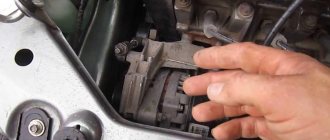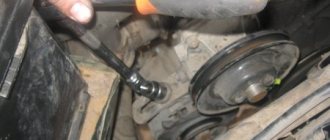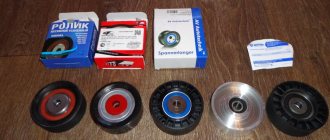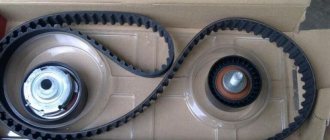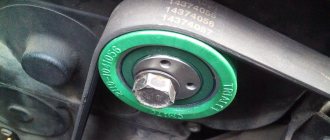The timing belt transmits rotational motion from the crankshaft to the coolant pump and valve camshaft. Replacing the belt and tension rollers is not difficult even for a car owner ignorant of the intricacies of mechanics. It is much more important to be able to correctly adjust the timing belt so that the clock sequence of the cylinders coincides with the operating mode of the intake and exhaust valves, otherwise the engine will “triple” or operate with a noticeable loss of power.
How to tighten the alternator belt
One of the technical works that a car owner can perform independently without involving car service specialists is tightening the alternator belt.
Driving a car with a loose alternator belt has a negative impact on the battery and can lead to its complete discharge and failure. That is why, when the first signs of weakening of the alternator belt appear, it is important to tighten it in order to normalize battery charging and the operation of the vehicle’s electrical equipment. Please note: On some vehicles, the alternator belt also drives the pump. If it is not tightened in time, it will lead to negative consequences. At a minimum, the risk of engine overheating will increase, which, in turn, may result in the need for major repairs.
General tips
Here are the rules that all motorists are advised to adhere to:
- Monitor the tension of the belt (it must be correct).
- There are car models with automatic tensioner. In this case, you need to be doubly careful, regularly diagnosing the correct operation of the machine.
- Always check the tension after procedures at a service station. Low qualifications of car service workers are no longer news. It is recommended to check the rotation of the shafts (they should spin easily).
- Pay attention to lubricant leaks.
When to tension the timing belt
The timing belt of the VAZ-2112 and other VAZ models is tensioned in the following cases:
- Installing a new belt;
- Loose belt;
- “Slipping” of the belt with a violation of the timing adjustment;
- Replacement of the tension roller and other timing drive mechanisms.
If the cause of the intervention is a broken or “slipping” belt, you must first ensure the integrity of the valves. A broken gas distribution mechanism (drive) leads to engine damage on 16-valve 1.5-liter power units. However, in cases of drive failure at high speeds, valves and CPGs are also destroyed on other engines.
They check the operation of the timing belt on the VAZ-2114 and other models equipped with 8-valve units by turning the camshaft manually. A working mechanism should turn with some effort. A faulty one, as a rule, cannot be affected.
During the procedure, it is necessary to check the compression in each of the cylinders. The easiest way to do this is to tightly cover the spark plug hole with paper. If there is pressure in the cylinder, the plug is knocked out of its seat at a certain stage of camshaft rotation. » alt=»»> A similar check on 16-valve engines is not recommended. The risk of damage to an initially good valve mechanism is too great. There are no grooves in the pistons of one and a half liter engines of this type. Therefore, valves that move down bend when they contact the piston surface.
When does the belt need to be tightened?
Having considered the previous paragraph of the article, it was probably not difficult to understand that monitoring the correct functioning of the timing belt is quite important. In particular, it is worth keeping the belt drive tension at the proper level. By the way, stretching is carried out only in two main cases:
- During a routine check of the gas distribution mechanism and the tension does not comply with the norm. The normal tension of the timing belt is checked in a very simple way, for which you will need ordinary spring scales and a ruler or caliper. To check, the hook of the scale clings to the belt and pulls until the display shows a load of 10 kilograms. Without loosening your grip, all that remains is to measure the deviation of the drive from the normal position. If the belt has been pulled back by more than 5.5 millimeters, but its tension is inevitable. Otherwise, you can leave everything as is until the next timing check, which is recommended every 10-15,000 kilometers;
- When repairing the timing belt, when the belt was removed or its tension was weakened.
In situations that do not correspond to those noted above, it is simply not worth touching the belt drive of the mechanism. Especially if the motor runs stably, without pronounced problems.
How to tension the timing belt. Correct timing belt tension on Kalina, and not only
There is no need to explain to anyone who understands at least something about cars how important it is to tension the timing belt correctly. Impacts on the casing when the timing belt tension is weak is the most harmless thing. Next, the belt can jump over the teeth, and this entails a violation of the valve timing. Significant jumping of the timing belt over the teeth can sometimes lead to almost the same disastrous consequences for the engine as a complete break. That is why the closest attention should be paid to the correct tension of the timing belt when replacing it.
How to tighten the belt on Kalina
Let's look at the correct tension of the timing belt using the Lada Kalina engine as an example.
So, before tensioning the timing belt, we turn off the engine after idling in neutral gear. But in this case the crankshaft does not stop at will, but only in those positions in which the forces acting on it are balanced.
Our task is to ensure uniform rotation of the crankshaft with minimal resistance before tensioning the timing belt.
1. Unscrew the spark plugs: the compression in the cylinders due to the tension of the timing belt is eliminated.
2. We get rid of the influence of the spring force on the timing belt tension: we hang up one of the driving wheels of the car, engage the highest gear and rotate the wheel by hand. A position in which there is almost no resistance to rotation means that the spring forces are in balance - exactly what we want.
3.Now we turn off the gear, and you can proceed directly to tensioning the timing belt.
I adjust the tension of the timing belt not by eye, but using a basic dynamometer and a simple hand-made wrench (see picture).
At a distance of 100mm, a recess is made on the shoulder of the key, to which we hook the hook of the dynamometer. The correct tension of the timing belt corresponds to a force of 2 kGs.
Having achieved this force, we press the curved part of the key against the end of the camshaft pulley bolt and hold it in this position. Tighten the tension roller nut.
All. We managed to tension the timing belt perfectly.
Audi 100
In general, Audi modernized almost all engines in 1991. Thanks to it, the optimal power values have shifted in the direction of cutting speed. Thus, this directly affected the nature of the tension of the rubber timing ring.
You should know that initially the belt on the Audi was tensioned using a pump. This was actually done only once, and then when replacing, a new belt was installed without any adjustments.
After modernization, instead of a stationary roller, a movable one equipped with a temperature compensation system was installed. This roller assembly was supplied assembled and cost about $130, but the owners rarely used the original ones and installed duplicates for $20 in order to save money when replacing them. But as a result of this, some Audi owners began to have problems; the belt periodically shifted and slipped out of place.
The task of adjusting the Audi timing belt comes down to ensuring that the belt can be twisted 90*, or in other words, one quarter of a full turn. Below are instructions on what and how to do if the tension is too strong or too weak.
Attention. If distance “A” is less than the above values, the roller should be replaced. The thermal roller performs several functions on Audi. Depending on the temperature of the internal combustion engine, the device changes the belt tension. You should know that when the motor gets very hot, the tension is automatically weakened.
This thermal device lasts for approximately 150 thousand miles, but there are exceptions.
In what cases is it worth replacing the belt? Signs that it is time to change the timing drive.
Replacing and tensioning the belt is carried out in two cases, namely:
- when a routine check of the entire gas distribution mechanism is carried out;
- if repairs were made to elements of the timing system.
To find out if the belt is tensioned correctly, you need to do the following. Take a regular canter and a ruler. Then everything is simple. Hook the canter hook onto the timing belt and pull. The scale dial should show a value of 10 kilograms. At this moment, measure the distance by which the drive has deviated. If the value is less than 5 and a half millimeters, then the tension is normal. When the value is greater than the specified figure, the timing belt needs to be tensioned.
Drive belt tension
The drive belt of the vibrating plate must be tensioned according to the following scheme:
- Before you start tensioning the V-belt, you should loosen the engine mounting nuts located on the clamps and the nuts on the rods;
- by tightening the external nuts on the rods, it is necessary to tighten the belt to a state in which the deflection of the span between the pulley and the coupling will not exceed 10...14 mm with an applied force of 40 N;
- after this, tighten the engine mounting nuts;
- you should check the relative position between the vibrator pulley and the coupling, the deviation should not exceed 2 mm;
- if the permissible deviation is exceeded, then it is necessary to correct the position of the nodes relative to each other.
Possible malfunctions in the electric generator drive and ways to eliminate them
Malfunctions in the belt drive of an electric generator during operation can manifest themselves in different ways:
- it may be a whistle from the drive location;
- This is a weak generator voltage, due to weak tension and periodic slippage of the belt drive. Slippage can also occur with normal, standard belt tension due to water, coolant or oil getting into the working elements of the drive;
- No less dangerous for the engine is too much tension in the drive. Due to excessively large loads, bearings may be destroyed (how to change a bearing on a VAZ 2114 generator?), gears or shafts damaged, and the belt may also break. In this case, further movement will be impossible until it is replaced with a new, working one. The worst situation is when a gust occurs on the highway, in a deserted place. Driver practice suggests that this does not happen very rarely.
Attention! Experts and experienced car owners recommend having a new belt in a spare set in the trunk, despite the fact that the driver can learn how to properly tension the alternator belt on a VAZ 2114 within 10 minutes. They also advise you to read an article about how to remove the alternator belt in order to be “savvy” for all occasions.
Since the condition of the generator belt drive is a vital issue, monitoring it is the responsibility of the driver. Checking the belt is quite simple - you just need to simply press it with a force of 10 kg to check the deflection. For an electric generator of brand 9402.3701 it should be within 0.6 - 0.9 cm, for brand 37.3701 - 1.0 - 1.5 cm. In addition, it is necessary to check the cleanliness of all drive elements.
If the driver hears that the generator belt is whistling, then it is imperative to immediately check the condition of the belt drive. The fact is that if the belt is really loose, it can twist and break at high speeds.
VAZ "Ten"
A popular car equipped with an engine with a timing belt drive. The manufacturer recommends replacing the rubber band of the GRS mechanism after 40-45 thousand kilometers, but diagnostics cannot be neglected before this period. The principle of “installing a new belt and forgetting about it” must be eradicated, understanding that being guided by this rule will not lead to anything good.
Attention. It is very important to regularly diagnose the technical condition of the belt and its tension.
In order to check the tension today, special electronic devices are used, although you can do without them. Only on the timing rubber product itself there should not be a drop of oil, dirt or signs of tear. Everything must be almost perfectly clean, without delamination, for the diagnosis to be most effective. Otherwise, it is better not to bother with diagnostics, but to immediately replace the belt with a new one, eliminating the reason why it was worn out or lubricant got on it.
Another important condition: the check must be carried out on a cold internal combustion engine.
The checking and adjustment process itself is as follows:
Now directly about the diagnostic process:
Attention. If the tension is accurate, the deflection should be 5.4 mm. Otherwise, adjustments will have to be made. If the value is less, then the tension is too strong; if it is more, the belt is too loose.
The adjustment is carried out as follows:
Note. The nut should be fixed so that the roller does not move and cannot be released.
It is also important to remember that excessive tension on the rubber timing ring reduces its service life and can easily lead to failure of the tensioner roller and even the pump. You should not listen to those false masters who claim that strong tension will supposedly eliminate all problems with the belt.
Weak tension always means the belt jumps over the teeth of the camshaft sprocket, which inevitably leads to disruption of the phases of the hydraulic valve mechanism. On the contrary, a strong tension is wear by the bearing of the same roller or water pump, as well as direct wear of the belt.
The tension can also be checked using a special device, such as “Contiteg”. The principle of its operation is quite simple, you just need to measure the amplitude of the belt vibrations.
The device always comes with a detailed description of its operation in a case. It consists of a device with readings, as well as a sensor, which must be brought to the belt (at a distance of 1 cm).
Attention. It is extremely important that the sensor “overlaps” the belt with only half its length.
There are three ways to tighten the alternator belt:
Using the adjustment bar
The generator set in many cars is fixed using a special elongated bolt on the crankcase of the power unit. This bolt allows the device to move in different directions. On top there is a bar in the form of an arc, on which there is a slot and a nut that fixes the location of the unit relative to the engine.
To tension the belt, do the following:
- Unscrew the nut on the bar using a wrench.
- Use a pry bar or pry bar to move the generator set away from the engine.
- Tighten the nut on the bar.
- Check the strap tension and repeat the procedure if necessary.
Bolt adjustment
Tensioning the drive belt using an adjusting bolt is one of the most convenient ways.
- Loosen the nuts on the mountings above and below the generator.
- Move the unit away from the block by turning the adjusting screw clockwise and at the same time checking the amount of tension on the product.
- Tighten the nuts back when the optimal tension is achieved.
Kia
On Kia cars, you first need to figure out where the belt is. Depending on the specific Kia model, the belt may be shaped like a semicircle or come out as a tensioner bolt.
Other important recommendations:
- The mark on the crankshaft pulley must match the mark on the cylinder head cover.
- When adjusting the tension, be sure to use the correct size wrench.
Tension is carried out by turning the bolt with a wrench in the opposite direction. If the tension is incorrect, the internal combustion engine will not function properly. And if it starts to whistle and make unusual noise, this is a clear indication of insufficient tension.
